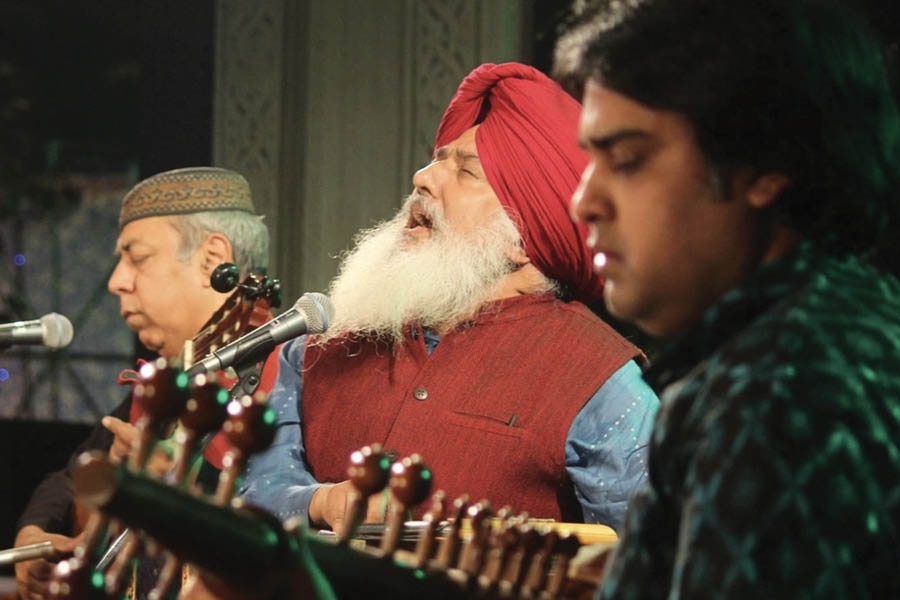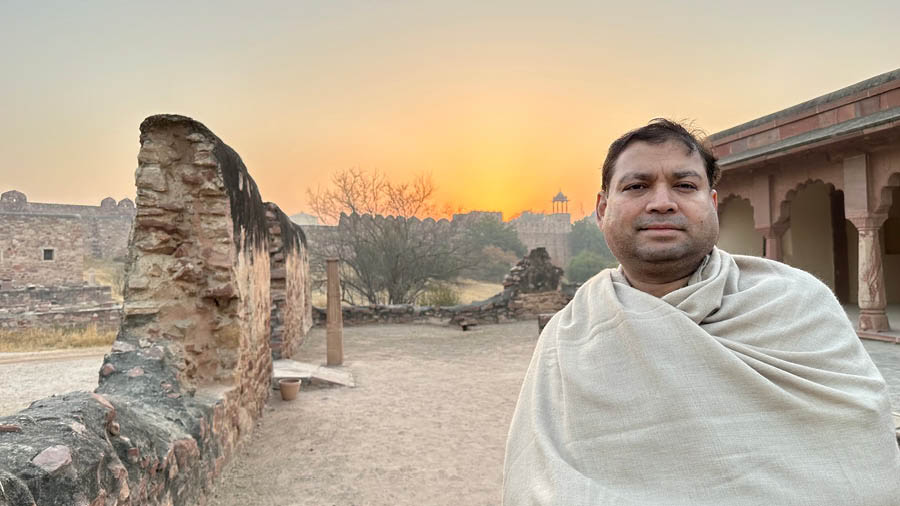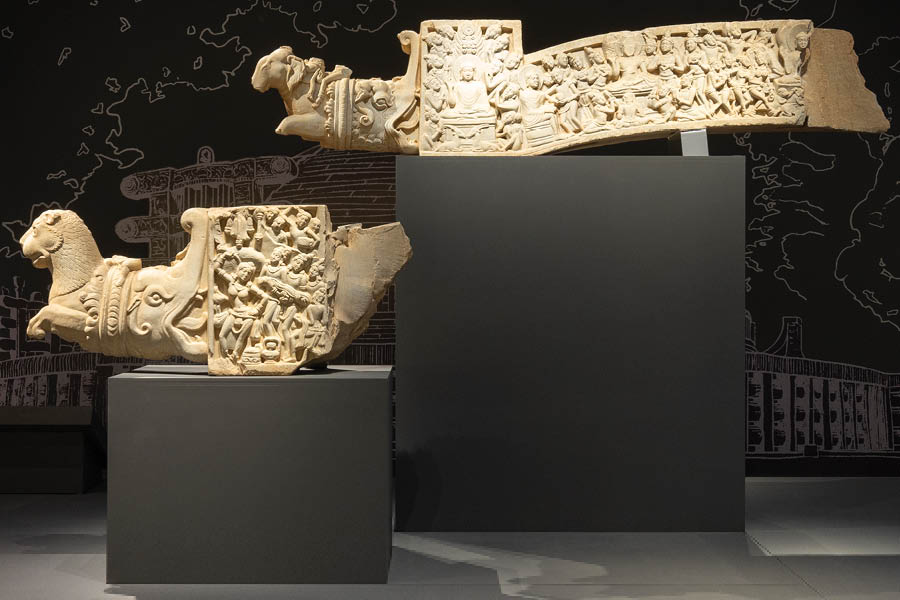As the sun rose over Nagaur Fort in Rajasthan, a woman strolled through a courtyard, her designer jamdani sari catching the morning breeze. She was carrying a book of Rumi poems, keeping her place with her finger as she transferred her contemplative studies from her tent accommodation to have breakfast. She caught my eye. “When the Sufi music is good,” she said by way of explanation, “you are not just listening to it from outside — It enters into your whole body and soul.”
So it does, when it is good. I’ve been attending Nagaur Sacred Spirit Festival — originally called Nagaur Sufi Music Festival — for about eight years, some better than others. This year (February 19-22, 2024) was good. Its inspiration is the town’s Sufi dargah, dedicated to saints Makhdum Husain and Hamid al-din Chishti. It was from Ajmer, where Sufism was introduced into the area, and from Nagaur that the Sufi message spread to attract people of all religions to live in peace and harmony. It became a vital connecting force in Rajasthan’s diverse culture, even if the proud Rajput soldier image is more familiar.

Nagaur Fort by day
ShutterstockNagaur became a great centre for education and pilgrimage; Sultan Muhammad bin Tughluq added a classy gateway, Mughal emperor Akbar stayed long enough to add rooms to the town’s massive fort. And it is inside this magnificent Ahhichatragarh fort that the festival takes place, where painted palaces and their water-gardens mostly created by 18th-century Jodhpur rulers still confound their desert location. More than 30 years of painstaking conservation of structures, stabilisation of Rajasthan’s most extensive and important collection of newly re-discovered murals, planting of gardens and mending of hydraulics are the backdrop to three days of concerts morning to late night, with lazy lunches and dinners in the great baradari. The keen hop up early to walk the walls at sunrise, the dedicated stay up late to experience midnight jamming in the intimate Akbar-period Deepak Mahal entirely lit by diyas in wall niches.
All the musicians, drawn from a variety of traditions across India and all over the world, are essentially following the Sufi path in that they intend to inspire and awaken our souls. They transcend communities, cultures, creeds
This, probably India’s largest and most significant conservation project, is our home for a special music festival. Our host is Bapji, as the Maharaja of Jodhpur, Gaj Singh, is known to all. It is he who has overseen Nagaur Fort’s revival, attends almost every concert, and congratulates every musician after their performances, however late.
All the musicians, drawn from a variety of traditions across India and all over the world, are essentially following the Sufi path in that they intend to inspire and awaken our souls. They transcend communities, cultures, creeds. We, their audience, are an equally eclectic group bonded by not just a love of music, but also open minds ready to experience bold and imaginative cross-cultural musical surprises.
We were given one of these on the festival’s opening night. Gathered beside Maharaja Bakhat Singh’s palace, Mukhtiyar Ali opened with some soft songs. He is an exponent of the Sufi tradition of the Mirasi community of Bikaner — the Mirasi live across northern India and Pakistan and their name is Persian for inheritance; the sound was appropriately timeless.
Mukhtiyar, who trained under Sufiana Qalam, explores all forms of spiritual expression of poetry — Kafi, Qawwali, Ghazal, Bhajan and KabirVani. We, the audience, were already content when the slim, elf-like Cherif Mbaw slid out from the shadows and began to wail quietly in counterpoint, a sound that ascended to be like the best of Bengali Baul singing, free-flowing howling. And Mukhtiyar replied in kind, the two traditions spiralling in harmony. Mbaw is from Senegal, whose music has roots in Wolof culture, which is linked to the Sufi Qadir brotherhood founded in the 11th century by a Persian scholar; this in turn inspired India’s Sultan Bahu, the great 17th-century Sufi Punjabi mystic, poet and historian. So, a long and global Sufi story landed back in India. Mukhtiyar and Mbaw mesmerised us as they let forth their passionate duet of Bahu’s poetry.
The next morning, Madan Gopal Singh, son of Punjabi poet Harbhajan Singh and a regular at the festival, sang Sufi poetry beneath the Peelu tree among the water gardens, extemporising, moving from Rumi to Baba Bulle Shah and across traditions and time to Simon & Garfunkel. Somehow, it worked. After lunch, he led us in a fleet of tuk-tuks across town to the dargah for some hearty Qawwali singing and a peek at the spanking new mosque, an indication of Sufi philosophy’s continued importance today. The knowing among us stopped on the way back to buy a bagful of this year’s renowned Nagaur red chilies.

Madan Gopal Singh
Madan Gopal Singh/FacebookAnother morning, again under the Peelu tree, Pandit Rajendra Prasanna and his three sons Rajesh, Rishab and Ritesh, arrived from Varanasi to play meditative morning ragas on the bansuri flute, with Athar Hussain on tabla. It was ragas and the poetry they inspired which later Indian painters tried to visualise in mood paintings. At the Jodhpur court, these paintings often included an identifiable palace or courtly garden at Nagaur. So, it was easy to let the music create a sublime experience.
Sunset is a special moment at the festival. While muezzins call a cacophony from the town’s mosques and children fly kites on rooftops, staff inside the quiet fort light hundreds of terracotta diyas to define our paths through the gardens, arcades, palaces, pavilions and baradaris. In this fairy land, we embark on evenings of three, sometimes four, concerts in different locations.
The sunset concerts in the Diwan-i-Am were especially thrilling this year. For one, the Shankar brothers – Sanjeev and Ashwani – played their hypnotic, haunting double-reed shenai. Part of the ancient Benaras gharana, the brothers continue the tradition of their two gurus: their father Daya Shankar and their grandfather, Anant Lal. I’ve seen a shenai being made in a little village near Kumbakonam in Tamil Nadu, then the maker walked me to the handsome but empty medieval village temple and played an evening raga sitting on the stone floor as the light faded. Magic. But the Shankar brothers forced their instruments into new trance-inducing territory.
At another sunset, our minds were wonderfully stretched by Parveen Khan’s deep powerful voice and Ilyas Khan’s beatbox of breathing gymnastics. There was a liberating wildness as they played around each other, across each other and then came together as one climactic sound.
At another, Lobsang Chonzor, born in Kalimpong of Tibetan parents in exile, was a terrific one-man band and entertainer. With a delightful wit and a mix of chanting, dancing and instruments including the long-necked dranyen lute, Chonzor single-handedly took us to his imagined Tibet as learnt from the Gangjong Doegar troupe of Kalimpong. Within a few moments, we were in tune with the richness of his now fragile and endangered culture. As he put it, with a big smile: “If you want to know what you were in the past, look at what you are today. And if you want to know what you'll be in the future, look at what you're doing today.”
A Tibetan proverb, but replete with Sufi thought. I’ll be back at Nagaur next year.
Louise Nicholson is a British art historian, journalist and writer who has focused her studies on India since 1978 and brings the curious to India. She has written 27 books, and writes a monthly wellness blog to inspire slow travel in India.








